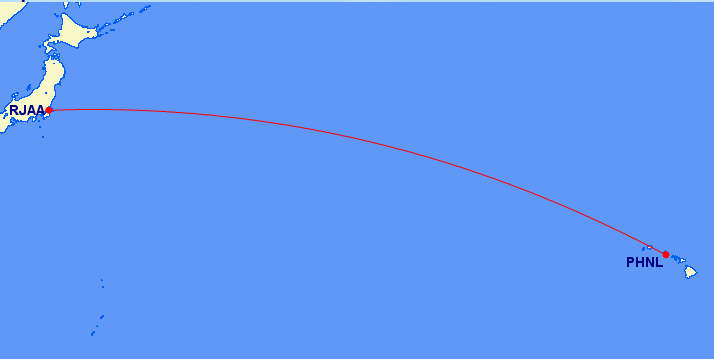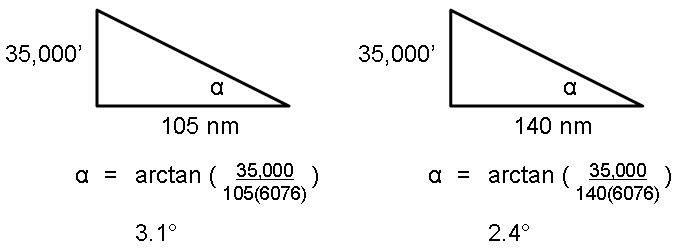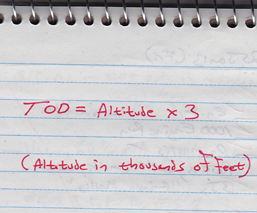The question of when to start your descent becomes a big deal for pilots when they start flying aircraft that fly at high altitudes, simply put. The dumb thing about Top of Descent, is how poorly some pilots make that decision. In the old days it was just a wag and these days it is a reliance on computers that may or may not know what you are doing. In either case, there is no doubt we can do a better job of . . .
— James Albright

Updated:
2015-03-18
. . . getting down gently.
In 1982 the best assignment in the Air Force I could imagine became available and all I had to do was interview. “It’s in Hawaii, the airplanes are great, the squadron is senior, and the mission is interesting,” the personnel officer said over the phone, “and you can’t beat the promotion rate.”
“You had me at Hawaii,” I said. So I interviewed and the next thing you know I was flying in paradise. It was the best flying in my entire three year career as a pilot, and as it turns out nothing in the thirty-plus years since can touch it. It was, in a word, great.
The EC-135J was a derivative of the C-135B, which itself came after Boeing learned all its mistakes after hundreds of KC-135As. Several airlines bought into the C-135B, known as a Boeing 707. It had incredibly long legs for its day; Honolulu to Tokyo was easily within its reach. But it was getting old and things started to break, engines started to blow up, the airplane was falling apart. But when you are 26 years old with a thirst for increased pilot bona fides, it was an excellent place to grow up.
Bigger engines, bigger wing, newer avionics; yeah, I could do all that. Air refueling as a receiver? Yeah, that came too. Check out was quick and easy, what I really wanted was to get on the road and to learn international operations from the pros.
I was assigned to Crew Five, led by Captain “Call me The Nick” Davenport, a junior captain in a squadron of majors and lieutenant colonels. The Nick was an excellent pilot and aficionado of “That Looks About Right” aviation. From the right seat looking left, everything seemed to be done with a minimum of effort, planning, or even thought. It just got done right, the first time and every time. I wanted to learn his secrets.
Lesson one came on trip one with a load of US Navy passengers on board heading to Japan. In undergraduate pilot training, most lessons come on a chalkboard, are spelled out in a lesson plan, demonstrated in the simulator, and then beaten into pilot skulls in the cockpit by an instructor with one mission in life: to teach. Flying the KC-135A tanker, lessons came pretty much the same way. In the EC-135J we had no stinking chalkboards, no stinking simulators, and the instructors were masters of “you figure it out” education techniques. Complicating things, I would soon learn, would be a young pilot’s ego unwilling to admit he didn’t know something he didn’t know.
We were at 36,000 feet, about forty minutes east of Tokyo and I was starting to think about my descent chores. The Nick was slumped backwards in his seat, comfortably, with a baseball cap doing a poor job of hiding his closed eyelids. I was thinking that around 36 times 3 plus 10, we would be starting down. In the tanker, dividing the altitude in thousands by the distance gave a good three degree gradient and a three degree gradient always worked. In my vast two years of experience flying that big jet, I knew thousands of feet times three gave about a three degree gradient, adding ten miles worked even better. Thirty-six times three plus ten, that’s 118 miles. Looking at our inertial navigation system I saw we had 200 miles to go, so we had plenty of time.
Flying the EC-135J on my first trip already proved to me the wisdom of leaving the KC-135A for greener pastures. In the tanker the copilot was glued to a High Frequency radio whenever flying oceanic. The tanker’s HF was a noisy, crackly, test of patience which would leave the user with a ringing in the ears and more often than not, a headache that lasted into the next day. In the EC-135J there were several HF radios but they were the domain of the radio operators. We pilots simply gave our position reports to the radio operators who did all the talking, listening, and migraine work.
The second boon to flying the newer bird was food. In the tanker our meals came in cardboard boxes produced by the hundreds in flight kitchens the day prior: mystery meat sandwiches with brown lettuce, stale crackers, an apple or an orange, and if you were lucky, a candy bar. In the new ride? We had a steward preparing full meals from fresh ingredients and sometimes even a menu with choices. It was great; except when it wasn’t. Back then we still called them stewards and they were all male. While we already hired our first female crewmember, she was a radio operator. On this first trip, the steward was Bruno, an aptly named Samoan-American who produced meals in the “it wasn’t” category. Still, it beat mystery meat boxed lunches.
“Hot towels,” Bruno announced as he barged into the cockpit. He threw the towels at the navigator and engineer, but offered them to us pilots in a tray. The Nick took his and threw it over his face. I gingerly held mine as the steam curled upward and it cooled enough for me to handle it.
“Ah,” The Nick said while handing the towel aft, “that was great.” He straightened himself in his seat, surveyed the instruments, and adjusted the boom microphone in front of his lips. “We talking to Tokyo yet?”
“Yup,” I answered.
“Get us clearance to start down,” he said.
A bit early, I thought, but I made the request, Tokyo said okay, and The Nick pulled the outboard throttles to idle and clicked off the autopilot. We were about 160 miles out, a good 30 miles early I thought. And what about the throttles? I knew that our descent gradient would be 360 hundreds of feet divided by 160 nautical miles, around 2 and one-fourth degrees; way too early. But it all worked out. I guess if air traffic control lets you do it and you have the gas to waste, you could get away with it. I would do better.
Once we were on the ground, it looked like The Nick’s primary job was herding cats, making sure the passengers got cared for, our aircraft secured, and all the cops, crew chiefs, radio operators, engineer and steward had beds for the night. Once we were out of uniform, The Nick’s primary goal was to eat, to drink, and to have fun. He was a one man party and just being in his outer orbit guaranteed a good time. We never spoke airplane stuff away from the airplane and it was the first time I realized that my chosen profession was what it is today: a never ending vacation.
Three days later it was time for Korea and my first live trip flying an airplane with a load of passengers sitting behind me. (All those pax missions in the tanker didn’t count; those were troops.) The EC-135J has a bigger wing and bigger engines than the tanker. It flew a little sloppier in the roll axis, but the power made it nice to get up and go. We were at 33,000 feet heading to Seoul, about 150 miles out, and The Nick was getting a little antsy. At 33 times 3 plus 10, 110 miles, I asked for clearance to start down, which he got from air traffic control. I pulled all four throttles to idle; my ears, and those of the thirty people behind me, all started to pop.
“Hey watch it!” The Nick said. He pushed the inboard throttles up, disabled the outboard spoilers, and moved the speed brake handle aft an inch. “These old birds leak air like a rusty sieve, so we can’t go to idle above 20,000 feet. You gotta plan on an earlier descent or plan on getting the airplane dirty first if you wanna use tanker descent rates.”
I didn’t want to use tanker anything, I wanted to learn to do things the EC-135J/Boeing 707 way. Now I understood the reason behind his inboard throttles technique: pressurization. But how did he decide when to start down?
“When I get a hot towel from the steward,” The Nick said, “it’s time to start down.”
What? He was joking, of course. But in my first lieutenant zeal to maintain the “I know that” persona, I just nodded and thought. Fortunately the rest of the descent worked out as did the landing. Nobody complained about their ears and all was forgotten.
We had several legs on the trip—Honolulu, Manila, Seoul, Tokyo, and back—and by Tokyo I still hadn’t detected rhyme or reason with the descent planning. “You just get a feel for it,” The Nick said.
Returning to Hawaii we were at 35,000 feet with the sky to ourselves. With 150 miles to go, The Nick said, “Tell Honolulu we are ready to start down.” In five miles our descent was approved and after another five we started down.
The descent worked perfectly. Again, it didn’t give me the clue I needed. The old heads like The Nick seemed to have a number in mind for every altitude, but were reluctant to share their secrets. I needed to figure out why the old rule worked before I could come up with a new one.
With a little trigonometry I already knew that a change in altitude divided by a change in distance divided by 10 equals the required gradient. (See “Penetrations”.) So what was the three times rule doing for us? If you started down from 30,000 feet at 90 miles, that comes to 30,000 / 90 / 100 = 3.33 degrees, call it three.
What about our Honolulu descent? From 35,000 feet we started down at 140 miles, which is 35,000 / 140 / 100 = 2.5 degrees.
The numbers weren’t making sense. If I were in the tanker at 35,000 feet, starting down at 3 x 35 = 105 miles gives me a three degree descent gradient. Starting down at 2.5 x 25 = 75 miles gives me steeper descent, not shallower. Huh?
Back to Trig 101. . .
Three times 35 is 105, easy. Two point Five times 35 is 87.5, which is not only wrong, but it is wrong in the wrong direction. A shallower descent requires more distance, not less.
Looking at my triangles I thought back to my days at Purdue. A friend came up with a theory that said, “If you are going to be wrong, chances are you will be wrong by a factor of 2, 5, or 10.” When dealing with slide rules back then, it was up to you to set the decimal point. Depending on where the error was in the equation, the impact could become a factor of 2, 5, or 10. That’s when it came to me.
Multiplying the altitude (in thousands of feet) by 3 resulted in a 3.3 degree gradient (give or take) because 3.33 was the reciprocal of 0.3. What about the reciprocal of 2.5? It was 0.4. Now I had something!
Four times the altitude (in thousands of feet) to lose, sure enough, produces a 2.5 degree gradient. As long as I was tweaking things, I decided to fix the whole “divide by 3 divide by 100” mess. We spent most of our flying in the world of flight levels, hundreds of feet. So the rule was finally written:

Start descent at three times your altitude to lose in thousands of feet to achieve a three degree gradient.
And as long as I was at it...

Start descent at four times your altitude to lose in thousands of feet to achieve a 2.5 degree gradient.
A year later, talking things over with The Nick, it seemed he knew about the three times and four times your altitude rules. “Why didn’t you tell me?” I asked.
“Why didn’t you ask?”
Why indeed. So that was the real lesson: If you don’t know, ask. A few years later The Nick was gone and I was the instructor. Watching a new crop of copilots I realized another caveat: “You don’t know what you don’t know.”
Postscript
Thirty years later, I found the original three times rule works best because Air Traffic Control expects it and doesn’t want to cede any more airspace than necessary. In many places, not even the three degree descent rule will work and the “slam dunk” approach rules the sky. But three degrees works more places than it doesn’t.
I was sitting in the jump seat of a Global Express corporate jet, giving a four-leg check ride to the two pilots sitting in Row One. The Global Express is a Gulfstream V wanna be: Bombardier claims it has the same range, it doesn’t; the same climb rate, it doesn’t, and the same sex appeal, it doesn’t. But the pilots had good reputations in the company and their jump seat was comfortable. Neither pilot had military pedigrees, in fact they were both short on corporate experience. Preston, the pilot, was a Cinderella Story. At age forty he decided being a CPA was no fun and he paid for flight school. He did everything right and made the right connections and in less than fifteen years found himself on top of the corporate pilot food chain. His first officer was an airline pilot furlough victim with limited experience thinking on his feet or flying outside of a regimented routine. But he was a good pilot nonetheless.
Our first leg was about a thousand miles to the Caribbean, cruising at 35,000 feet. Huh? Any sane Gulfstream pilot chooses an optimal altitude to minimize fuel burn and maximize passenger comfort. In the old days, some were reluctant to fly much above 40,000 feet for various unmanly reasons, but in my experience the GV flies best around 47,000 feet. I’ve never met a Global Express pilot willing to fly that high. Preston had planned each of our four legs in the low thirties, Boeing 707 territory. We all make mistakes and from the jump seat I knew perspective changes. Still, I looked for some sign the pilots recognized their error. They did not.
I was surprised when he needed fuel after the first leg. I was stunned when he needed it on the second leg. I started to examine what they were doing that was eating up so much gas. On leg three we were cruising at 33,000 feet for a flight of just over 600 miles, the fuel flow was just over 2,500 pounds per hour per engine. I would have been in the upper forties and my fuel flow would have been about half. Okay, that was reason one, but there had to be more.
The flight management system is almost identical to what I was using in my GV except they had a vertical situation display in view that I normally toggled off. It was something Honeywell, the FMS designer, never quite got right. A green square labeled “TOD” crept slowly to our position. I think the Top Of Descent cue was based on the FMS’s best guess of track miles, but I don’t really know because I never trusted it in the first place. But Preston had the display up and when the airplane icon hit TOD, Preston started down. We were 200 miles out.
Two hundred miles? That’s 330 / 200 = 1.65 degrees. We spent a lot of time droning at low altitude where our fuel flows were even higher. I guess this was reason two.
After another fuel truck it was time for leg four and another flight at lower than optimum altitude. We were at 34,000 feet. This time TOD was late. I was primed for 34 times 3 equals 102 nautical miles. When that came and went I notice TOD was absent without leave. Air traffic control gave us descent clearance without being asked and we started down, at a leisurely pace. As an evaluator, I am supposed to keep quiet unless I see something unsafe. In the Air Force, we would say any comment from the evaluator is bad news. I kept my mouth shut.
Right around 18,000 feet both pilots knew something was wrong and Preston pulled the speed brake handle to expedite things. We had to fly a 360 to lose altitude but things eventually worked out and the flight, and the check ride, was over.
“When do you decide to start down?” I asked both pilots during the debrief
“TOD,” the both said at once. Preston explained that the Global’s FMS was notorious for errors when computing TOD but a software fix was in the works. Until then, “nothing can be done.”
I explained that their last leg’s TOD was missing because the first officer inadvertently deleted the field elevation line so the FMS didn’t have a destination altitude for the vertical navigation computer. “Oh,” they both said, “we will have to check that from now on.”
Then I explained how to compute their own TOD: altitude in thousands times three.
“We can’t do math,” they both said. “We will make sure we have a valid destination altitude in the box from now on. Thanks!”
I took out a pad of paper and wrote. When an evaluator writes in front of pilots, pilots tend to fall silent. “Take this,” I said, “and paste it on top of the pilot’s FMS. Do it a few times and you will have it memorized and will never again blow a descent.”
“Okay,” they lied, “we’ll do that.”



